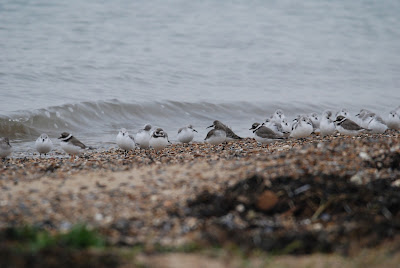It’s been a while since I last visited and in truth, the day and weather was not ideal with very strong south westerly winds, anything that did show, especially small stuff quickly disappeared seeking shelter.
Having just finished a survey in the afternoon I had a couple of hours to spare so I walked the foreshore and then the reserve.
As expected there were no waders on show on the river and not a duck of any kind, I did get lucky with 6 Rock Pipits, likely fresh in and doing there level best to keep their feathers on and hide behind something.
 |
| Rock Pipits |
I did not expect to see much on the reserve but good to see Wigeon in with around 140 birds seen, Shoveler, Gadwall and Teal were also present in decent numbers.
A single Stonechat was seen holding onto a fence wire, a Chiffchaff in the woodland and a flock of around 80 Goldfinch were feeding in cover.
 |
| Stonechat |
What I do find strange is the water levels, Aveley Pools has a good level albeit too high to attract waders and the rest of the reserve seems to be bone dry. The brand new hide has no water in front of it, what is the point of sitting in it if there is nothing in front of you to see. Likewise Purfleet Scrape is bone dry, this has been remodelled a number of times over the years but it always dries out, why?
 |
| New Hide, unfortunately no birds in front of it |
Having birded Rainham Marshes for 30 years you know and can see its potential to bring in large numbers of waders and wildfowl, it’s a pity that it is under achieving due to a lack of water. When the Reserve floods and does hold water it pulls in large numbers of Wildfowl, it is a different place entirely. By now the water levels should be sorted out and constant, they are not, looking inland from the Visitor Centre, the nearest area of standing water is Aveley Pools.
 |
| Fox near woodland |
What of the Silt Lagoons, the number of birds that these held was phenomenal when they held water, the regulars will tell you, I can still remember quite clearly flushing a group of over 40 Green Sandpipers at roost one morning, it has now been years since they opened the sluice gates and they have remained dry ever since. Again the potential is there but will anything ever be done to realise it, it has been a number of years since they held water, hopefully there are plans to bring them back to their former glory.
Here’s hoping for some rain.

















































